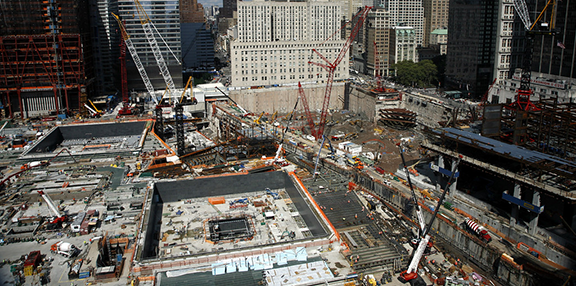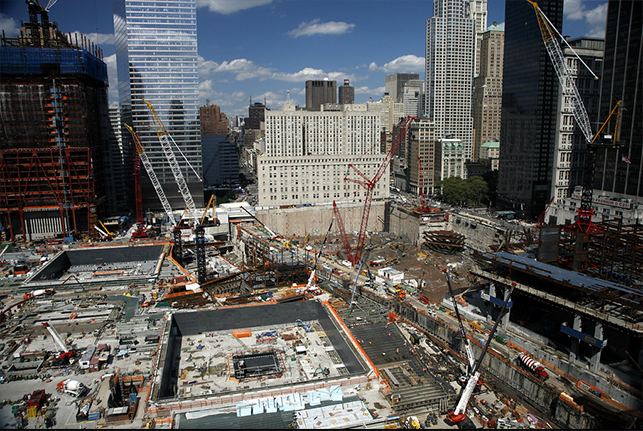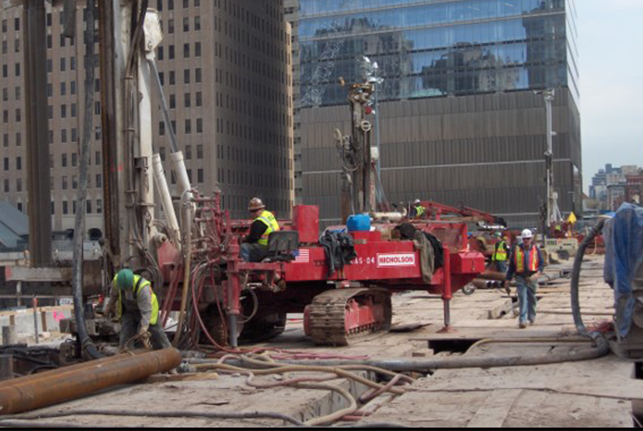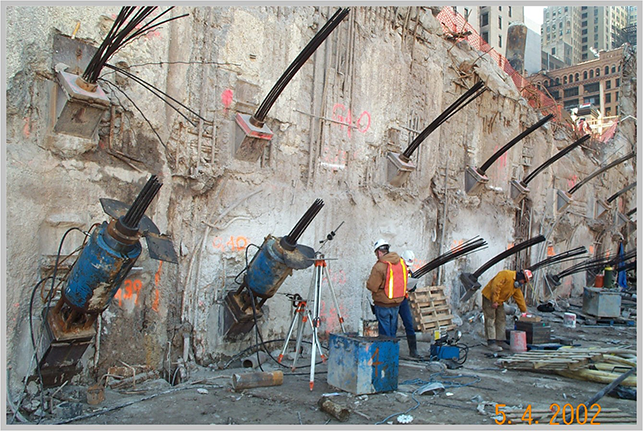
Rebuilding the World Trade Center Site: Looking Back 20 Years after 9/11
After the fall of the World Trade Center towers on September 11, 2001, people from across the country stepped up to help in any way they could. The engineering community, in particular, rose to the challenge, from stabilizing the site for rescue and recovery to later rebuilding infrastructure and creating a new legacy and memorial for the site.
Among those contributing were two CEE alumni, Seth Pearlman (BS ’78, MS ‘79) and John Wise (BS ‘84). Both men worked for Nicholson Construction Company, a firm that specialized in geotechnical engineering and foundation work, and, in total, Wise spent nearly a decade of his career working on and off at the World Trade Center site.
 “The work was fast paced and changing all the time,” recalls Wise. “Someone would design something one way because of how they thought it looked. Then when you got down there, the actual conditions were very different. Both the design and construction team had to be very agile. Especially in the early years, everyone was working closely together.”
“The work was fast paced and changing all the time,” recalls Wise. “Someone would design something one way because of how they thought it looked. Then when you got down there, the actual conditions were very different. Both the design and construction team had to be very agile. Especially in the early years, everyone was working closely together.”
From 2003 to 2012, Wise managed a range of projects at the site as Nicholson’s VP of Operations and head of the New York office. In 2003, he oversaw the construction of a support system for an elevated pedestrian bridge to reconnect the World Financial Center to the redeveloped World Trade Center. In 2007, his team assisted in creating a new Transportation Hub that linked the subway system and the PATH (Port Authority Trans-Hudson) train, installing micropiling so that crews could dig and work underneath an active subway line. The following year , the team began work on the Memorial Plaza, now home to the memorial reflection pools and a 100,000 square-foot underground museum. Other large projects included excavation and foundation work for a security center for vehicles entering the complex.
“During the rebuild in the mid 2000s, I was there 35 to40 weeks a year,” says Wise. “I was involved at many levels from attending meetings with the building owner to going onto the work site and figuring out why a particular the machine wasn’t working.”
With the site’s location at the tip of Manhattan, logistics were immensely complex and the scale of the work necessitated collaborating with many engineering, design, and construction firms as well as with the building’s owner and management. The level of innovation involved was also noteworthy. “Because of the existing subway, the disturbed ground, and the need to preserve some of the old foundations for the memorial that you see in the museum today, it made for some very unique designs and that required innovative means and methods of construction,” Wise shares.
 While Wise spent the most time on-site from 2003 to 2011, he also played a supporting managerial role in the recovery stage work Nicholson Construction did immediately following 9/11. That project was initiated largely by fellow CEE alum Seth Pearlman, who was Vice President of Nicholson Construction at the time of the attacks. After the towers fell, Pearlman realized that the firm could assist with the rescue and recovery efforts. “We were already known for working in large urban excavations below the water table,” says Pearlman, “The work that they needed to do to dig it all out, to recover the people, and to begin rebuilding, that was in our expertise.”
While Wise spent the most time on-site from 2003 to 2011, he also played a supporting managerial role in the recovery stage work Nicholson Construction did immediately following 9/11. That project was initiated largely by fellow CEE alum Seth Pearlman, who was Vice President of Nicholson Construction at the time of the attacks. After the towers fell, Pearlman realized that the firm could assist with the rescue and recovery efforts. “We were already known for working in large urban excavations below the water table,” says Pearlman, “The work that they needed to do to dig it all out, to recover the people, and to begin rebuilding, that was in our expertise.”
Within just two weeks of 9/11, Pearlman was visiting the grounds and, by early October, the Nicholson Construction team was beginning work. Their most pressing item of focus was the World Trade Center’s bathtub wall. Previously held in place by the building’s concrete floors, the bathtub wall supported the entire site, holding back not only the soil but also the Hudson River.
“When the floors got crushed down, there was no way you could excavate that site without anchoring the walls back, or they would come in against the pressure of the earth and water,” Pearlman explains. “The initial job was just to anchor the whole thing back. We consulted on making sure that was schemed out correctly and that it could be done in a way that allowed them to safely dig the building down.”
One wall had already shifted 12 inches in parts, and the engineers moved rapidly to establish and implement their plan. Ultimately, the team reinforced the walls with over 1000 tieback anchors drilled into the bedrock, securing the site for the removal of over 1.5 million tons of debris in a clean-up process that lasted through May of 2002. Today, the intact slurry wall reinforced by Nicholson Construction during the recovery period is on display in the World Trade Center Museum that they also helped construct.
Reflecting on their work at the World Trade Center, both CEE alums are grateful to have participated in such a monumental effort. “It's something that's bigger than yourself,” asserts Pearlman. “If you have the capability to make a contribution or to influence the way decisions are made and you think your knowledge is valuable, then you should offer it.”
Though the work undoubtedly had challenging moments, being involved with something so important to New York City and to the entire nation was personally and professionally rewarding. “The time there was definitely one of the highlights of my career,” says Wise. “I was proud to say that we were there and we were helping.”

World Trade Center site overview in reconstruction phase
(Photo: John Wise)

World Trade Center Reconstruction – Drilling piles for the support of the 1 & 9 Subway Line.
(Photo: John Wise)

World Trade Center recovery work – Anchor stressing
(Photo: John Wise)